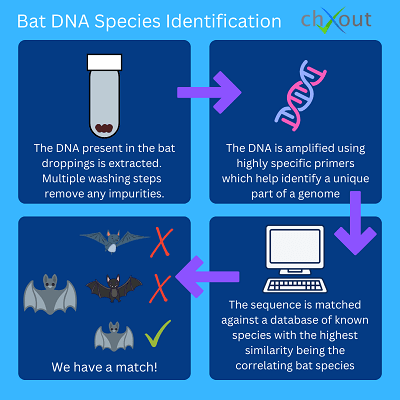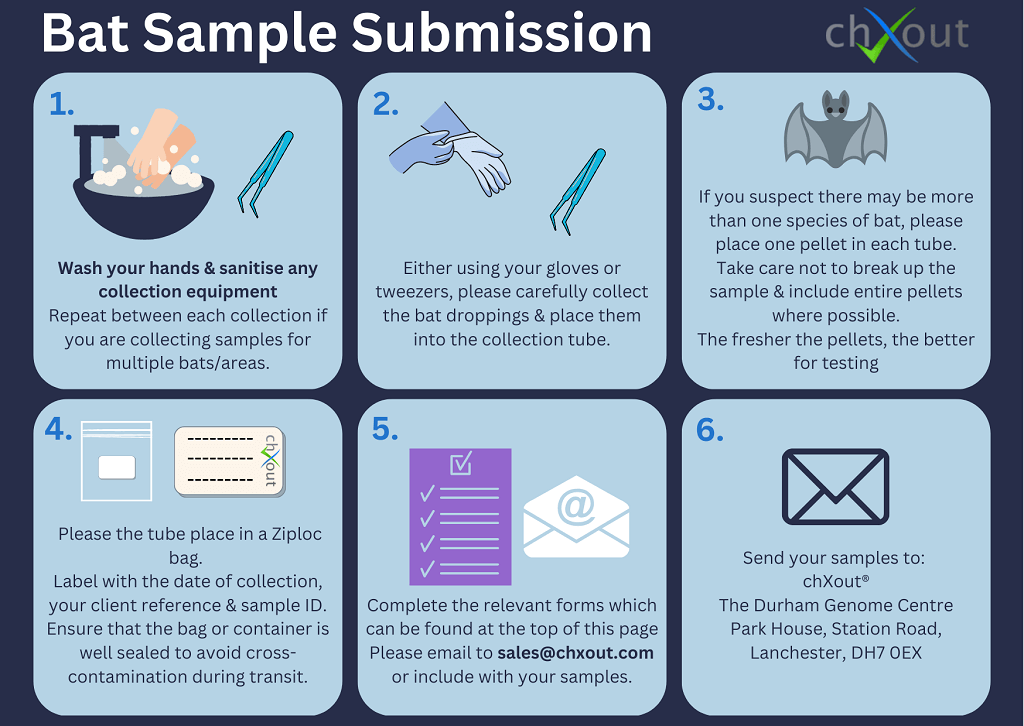
Bat species ID through DNA testing can complement traditional surveying methods and ecological studies, revolutionising the way ecologists are able to survey organisms and their habitats.
DNA analysis is a powerful tool for surveying bats without disturbing, capturing or physically identifying them. It has been developed as a quick and accurate alternative to traditional surveying methods.
UK bat populations have declined drastically in the last century. Their breeding sites and resting places are fully protected by UK and European law. It is illegal to harm or disturb bats without seeking specialist advice. Find out more about UK bats from the Bat Conservation Trust.

ECOLOGY & CONSERVATION
Effective and accurate species identification is necessary for planning, conservation and population growth projects.
An example of DNA analysis being a valuable tool for species identification is with the visually very similar grey and brown long-eared bat species. Grey long-eared bats are considered very rare in the UK with brown long-eared bats relatively common which means that having an effective method of species identification when researching population size is very important. You can find out more about this in our Finding rare bats with DNA testing blog highlighting the work of similar laboratories to ourselves.
HOW DOES BAT SPECIES ID USING DNA WORK?
Our bat species ID testing service is made possible by using sophisticated molecular genetic techniques to analyse the DNA found in guano (bat faeces). With our bat species identification service, we can accurately and cost-effectively identify bat species known to be breeding in the UK.

First we extract the DNA present in the bat dropping sample and carry out multiple washing steps to remove impurities. Short fragments of a mitochondrial gene region (COI) are amplified with polymerase chain reaction (PCR) using highly specific primers. This is carried out using quantitative PCR (qPCR) technology. After further cleaning steps, the DNA is then run through our state-of-the-art genetic analyser and matched against a database of known species, with the highest similarity being the correlating bat species.
UK BAT SPECIES
There are 18 species of bat in the UK, 17 of which are known to breed here, all of which are European protected species.
Barbastelle (Barbastella barbastellus)
Bechstein’s bat (Myotis bechsteinii)
Brandt’s bat (Myotis brandtii)
Brown long-eared bat (Plecotus auritus)
Common pipistrelle (Pipistrellus pipistrellus)
Daubenton’s bat (Myotis daubentonii)
Greater horseshoe bat (Rhinolophus ferrumequinum)
Grey long-eared bat (Plecotus austriacus)
Leisler’s bat (Nyctalus leisleri)
Lesser horseshoe bat (Rhinolophus hipposideros)
Nathusius’ pipistrelle (Pipistrellus nathusii)
Natterer’s bat (Myotis nattereri)
Noctule (Nyctalus noctula)
Serotine (Eptesicus serotinus)
Soprano pipistrelle (Pipistrellus pygmaeus)
Whiskered bat (Myotis mystacinus)
TIMESCALES &PRICING
COLLECTING YOUR SAMPLE

Useful notes
- We recommend collecting at least five droppings where possible in case a retest is required.
- It is also a good idea to keep a couple back in case of postage problems.
- If not using our sample collection materials, please use a small tube or Ziploc bag to collect each sample.
- Please try to keep the individual droppings in one piece.
- The more recent and more intact the sample, the better.
- If you suspect multiple species please use one container per pellet/dropping.
- If there is a delay between sample collection and postage it is not necessary to freeze or refrigerate the sample.
DNA BAT SPECIES ID FAQs
If you think there may be mixed species present it is best to try to send an individual pellet and a back-up sample in case a re-test is required. The fresher the sample the better and please try to avoid breaking up the pellets.
Within these epithelial cells are mitochondria. Mitochondrial DNA is widely used in species identification because it evolves much more rapidly than nuclear DNA, this leads to an accumulation of differences between closely related species. Within the mitochondrial DNA is the ND1 gene, it is a standard gene for mammalian species testing. Unfortunately, there are several agents present in both faeces that may interfere with our testing process, we therefore have to remove these inhibitors so we may extract the DNA.
Once we have extracted the DNA we analyse and compare it to a database of reference sequences. The result tells us how closely the ‘unknown’ sequence matches, therefore identifying the species.

• 4 working day turnaround: £54 incl. VAT
• 3 working day turnarrund: £66 incl. VAT
The day the sample arrives at the laboratory is considered 'day 0'.
If your results are ready early we will email them to you as soon as they are available.
As long as you have sterilised any equipment used to collect the sample and have a new screw top/centrifuge tube or Ziploc bag you can pop your samples in the post to us. The sample submission form can be found at the top of this page. It can be emailed to us or included in the envelope with your samples.
If you think there may be mixed species present it is best to try to send an individual pellet and a back-up sample in case a re-test is required. The fresher the sample the better and please try to avoid breaking up the pellets.





